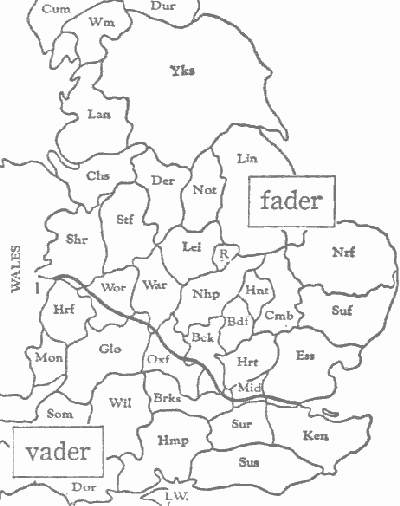hellog〜英語史ブログ / 2015-05-25
01 02 03 04 05 06 07 08 09 10 11 12 13 14 15 16 17 18 19 20 21 22 23 24 25 26 27 28 29 30 31
2015-05-25 Mon
■ #2219. vane, vat, vixen [phonetics][phonemicisation][consonant][me_dialect][cornish][map][etymology]
標記の3語は,歴史的に非常に稀な経路を通じて標準英語に入り,定着した語である.vane (風見,風向計),vat (醸造用などの桶),vixen (雌ギツネ)は,いずれも語頭に有声摩擦音 v をもっている.語頭に v があるだけでは稀でも何でもないのだが,(雄)キツネを表わす fox に対して雌ギツネ vixen を比べてみて想像されるように,この3語においては語源的に無声摩擦音 f が予想されるところに有声摩擦音が現われる点が特異なのである (cf. OE fana, fæt, fyxen) .歴史的には,中英語期に特定の方言でのみ語頭の無声摩擦音が一律に有声化し,その分布は地理的に限られていたが,この3語についてはどういうわけか後に標準英語へと発展する変種に取り込まれ,一般化したのである.今となってはほとんど気づかれないが,この3語は子音の「訛った」発音に由来するのである (cf. vixen については,American Heritage Dictionary による vixen の注も参照).
この「訛り」は,現代のイングランドでは南西部に存続している.南西部方言では語頭に [f] のあるべきところで [v] が現われるのみならず,[s], [ʃ], [θ] のあるべきところで各々 [z], [ʒ], [ð] が現われるといったように,摩擦音系列全体に対応がみられる.Upton and Widdowson (52) の方言地図より,finger の語頭音について方言分布を示そう.

イングランドの最南西端,Cornwall の末端では標準的な [f] が行われているが,これは Cornwall 方言が南西部方言の英語の流れを汲むものではなく,近代期に従来のケルト系言語 Cornish を置き換えた標準英語にルーツをもつものだからである (cf. 「#779. Cornish と Manx」 ([2011-06-15-1]),「#2025. イングランドは常に多言語国だった」 ([2014-11-12-1])).
さて,現在では語頭の [f] に代わる [v] の分布は南西方言に限られているが,中英語期にはイングランド南部に広がっていた.この広い範囲で,おそらくすでに古英語期から語頭の摩擦音の有声化が始まっていたものと思われる.中英語での fader と vader の分布を Plan and Bibliography (9) に基づいた中尾 (101) の地図でみてみよう.

古英語では,南部諸方言で件の変化が生じるまでは,方言にかかわらず [v] と [z] は語頭に生じることはなかった.ところが,中英語では,この変化の生じた方言のみならず広く一般に両音が語頭に生じることが可能となった.Lass (58--59) は,この語頭音としての [v], [z] の一般的な許容の理由の1つは,まさに南部諸方言に生じた摩擦音有声化にあるとみている (cf. 「#1222. フランス語が英語の音素に与えた小さな影響」 ([2012-08-31-1])) .
A third factor, perhaps the most likely, was the existence in Middle English of varieties that had in Old English times undergone voicing of initial fricatives. Many southern dialects had voiced at least initial /f s/ --- a development whose relics survive still in the rural West Country ('Zummerzet'). This parallels, and may well stem from, the same process in continental West Germanic: the <v> in G Vater 'father', now pronounced with /f/, and Du. initial <v> and <z> in vader and zon 'sun' (/f s/ in more innovating dialects, still /v z/ in conservative ones) reflect this. While the voicing in England was mainly southern, it did extend well up into the midlands in Early Middle English, and the standard still has a number of forms with voiced initials like vat, vixen, vane (OE fæt, fyxen, fana). Contact between speakers of these dialects and others without voicing may have facilitated borrowing of French /v z/, making them less 'outlandish'.
・ Lass, Roger. "Phonology and Morphology." The Cambridge History of the English Language. Vol. 2. Cambridge: CUP, 1992. 23--154.
・ Upton, Clive and J. D. A. Widdowson. An Atlas of English Dialects. 2nd ed. Abingdon: Routledge, 2006.
・ Kurath, Hans, Margaret S. Ogden, Charles E. Palmer, and Richard L. McKelvery. Plan and Bibliography. U of Michigan P, 1954.
・ 中尾 俊夫 『英語史 II』 英語学大系第9巻,大修館書店,1972年.38頁.
2026 : 01 02 03 04 05 06 07 08 09 10 11 12
2025 : 01 02 03 04 05 06 07 08 09 10 11 12
2024 : 01 02 03 04 05 06 07 08 09 10 11 12
2023 : 01 02 03 04 05 06 07 08 09 10 11 12
2022 : 01 02 03 04 05 06 07 08 09 10 11 12
2021 : 01 02 03 04 05 06 07 08 09 10 11 12
2020 : 01 02 03 04 05 06 07 08 09 10 11 12
2019 : 01 02 03 04 05 06 07 08 09 10 11 12
2018 : 01 02 03 04 05 06 07 08 09 10 11 12
2017 : 01 02 03 04 05 06 07 08 09 10 11 12
2016 : 01 02 03 04 05 06 07 08 09 10 11 12
2015 : 01 02 03 04 05 06 07 08 09 10 11 12
2014 : 01 02 03 04 05 06 07 08 09 10 11 12
2013 : 01 02 03 04 05 06 07 08 09 10 11 12
2012 : 01 02 03 04 05 06 07 08 09 10 11 12
2011 : 01 02 03 04 05 06 07 08 09 10 11 12
2010 : 01 02 03 04 05 06 07 08 09 10 11 12
2009 : 01 02 03 04 05 06 07 08 09 10 11 12
最終更新時間: 2025-12-21 10:41
Powered by WinChalow1.0rc4 based on chalow